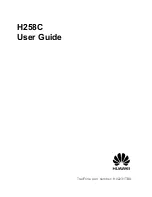
19
DVP-NW50
2.
Confirmation of wiring environment
2-1. Network Wiring patterns
A. Broadband router (4, 8 or 16 port: built-in type) is used.
B. Broadband Switching HUB (4, 8 or 16 ports etc.) is
used.
C. Switching HUB is used.
2-2. At the Broadband router use (type A and B)
Confirmation of the Broadband router setup
(Refer to the manual of the router for details.)
1. Confirmation of the WAN side setup (the Internet side)
• IP Address, Subnet Mask, Gateway
It follows the instruction of the Internet provider.
(Normally, Auto is selected.)
• DNS
It follows the instruction of the Internet provider.
(Normally, Auto is selected.)
2. Confirmation of the LAN side setup (the InWall network side)
• IP Address, Subnet Mask
The followings are recommended unless otherwise specified.
- IP Address : 192.168.xxx.001 (xxx: It depends on the
router. It is fixation/changeable.)
- Subnet Mask: 255.255.255.000
• DHCP
DHCP should be set to “Valid” unless otherwise specified.
It is one example of the setting related to DHCP
- Starting IP Address : 192.168.xxx.020
- Max number of DHCP : 100
In this case, the area from 192.168.xxx.002 to 192.168.xxx.019
can be used as the fixed IP region.
The IP Address from 192.168.xxx.020 up to 100 maximum
becomes the automatic assignment region.
2-3. At the both the broadband router and the hub are
used (type B)
[Router setup]
Refer to the above description.
[Hub setup and connection]
Verify connection between router and hub. (For details of connection,
refer to Operating Instruction of the respective equipment)
The connection methods between router and hub are different
depending on the hub type.
1. When a hub has the UpLink dedicated terminal:
Connect a hub to a router using the dedicated terminal. In this
connection configuration, leave the neighboring ports of the
dedicated terminal the blank (unconnected) ports to which any
equipment should not be connected.
(For details, refer to Operating Instruction.)
2. When a hub has the UpLink ON/OFF selector switch:
Set the UpLink ON/OFF selector switch to ON, and connect a
hub to a router.
3. When a hub does not have the UpLink function:
Connect a hub to a router using a [Cross-cable] (sex inverted
cable).
(This connection is not recommended because this connection
becomes an exceptional connection since almost all other
connections are performed using the straight cables.)
2-4. Broadband router and hub specifications
Both must support 100 Mbps. (Cables must support 100 Mbps too.)
If a hub that supports only 10BaseT is used, noise occurs in the
playback sound during streaming.
2-5. Verification of the connected equipment
Verify what types of equipment are connected to the LAN other
than the InWall Unit.
•
PC with [Utility for InWall Unit]
(The InWall system supports only a single unit.)
If any network equipment as listed below, of other types than the
InWall Unit is connected in the same LAN, 100% guarantee of the
InWall Unit network operation becomes difficult.
•
Network AV players
•
PC in which server software controlling contents of the above
players is installed.
















































